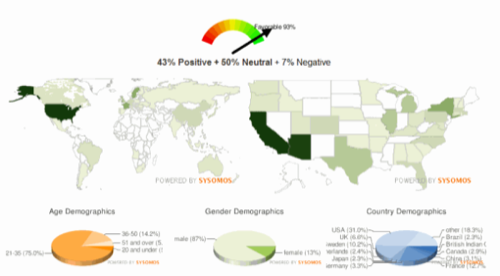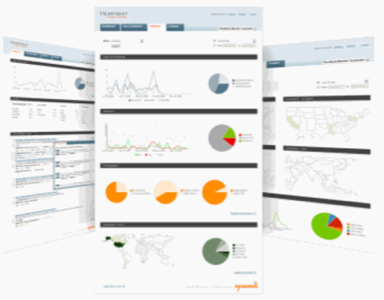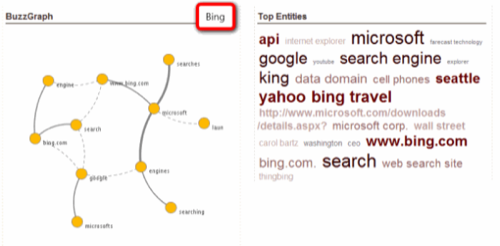Sysomos, a Toronto-based startup, officially launched its two flagship products this morning: MAP (which stands for ‘Media Analysis Platform’) and Heartbeat. Both products are incredibly powerful (but costly) social media monitoring and analysis tools. In many ways, it is probably best to think of MAP and Heartbeat as companion pieces. Heartbeat basically provides a subset of MAPs features and is somewhat similar to Radian6‘s social media tools, with a strong focus on making it easy for companies to track social media metrics. MAP, on the other hand, is a far more powerful and flexible analysis tool.

What can MAP do for You?
Maybe the real question to ask is actually: What can’t MAP do? MAP gives its users the ability to research any topic on blogs, social media sites, and in traditional news media reports.
MAP can, for example, tell you that the largest number of Twitter users who wrote about the Palm Pre come from California and Great Britain, as well as who the most authoritative Twitter users who tend to tweet about the Pre are (MAP assigns a score from 1 to 10 to every Twitter user, based on the number of followers, replies, retweets, etc.). Of course, you can then also compare these results with results from a query for ‘iPhone,’ for example.
This video gives a good, quick, overview of what the Sysomos tools can do. Usually these promotional videos tend to be a bit exaggerated, but in our experience, MAP and Heartbeat fully live up to their promises.
But MAP is not just a tool for analyzing tweets. It can also quickly give us a history of when and how often a Wikipedia article was edited, or what the most popular forum posts and YouTube videos about the any given topic were in the last 30 days.
For PR firms, another interesting function is MAP’s ability to create a list of the most authoritative blogs (and blog posts) about any given subject. This way, a firm can quickly create a list of blogs to contact about an upcoming launch of a rival phone, for example (for the Pre, by the way, MAP identified CNET and Engadget as the top blogs). Once a firm has identified these blogs, MAP can also provide a detailed analysis of the topics these blogs tend to write about, how many posts per month they publish (almost 1000 per month for Engadget) as well as a list of blogs that tend to link to this blog’s content.

On the technical side, Sysomos is obviously doing some very interesting semantic analysis, which, among other things, allows the software to create very cool ‘BuzzGraphs’ that display the key search term in relation to the most often used terms around it (here is one for ‘Conan,’ for example). MAP can also do sentiment analyses, which will be really helpful for PR firms who want to track the result of a campaign, for example. Given that MAP users can filter results by time, demographic, or language, the tools allow for some very detailed analysis.
Both MAP and Heartbeat are surfing the current wave of enthusiasm for the real-time web, and MAP’s crawlers index an enormous number of blog posts, forum posts, news reports, and tweets every hour. One interesting aspect of Sysomos’ backend is also that the company keeps a complete cache of tweets, blog posts, and news reports on its own servers, so that it never has to rely on the availability of Twitter’s API, for example. Amazingly, Sysomos also manages to effectively filter out blog spam, which is not an easy feat.
Monitoring the Heartbeat
If MAP is for PR firms and maybe even news organizations who want to be able to analyze the reaction from social media sources about a given topic, Heartbeat is the companion product that firms would probably set up for their clients to use, as its focus is on monitoring specific terms in real-time. Besides giving users an overview of the most recent posts that included a specific keyword (usually a brand name in this context), Heartbeat also tracks data about sentiment, demographics (age, gender, location), and the language they wrote in.

Heartbeat, which comes in a standard and pro version, doesn’t feature all the in-depth analysis tools that MAP offers, though both products are based on the same platform. Instead, Heartbeat provides users with an easy to use dashboard, where they can track new blog posts and tweets about a product, for example. Here, users can then also tag specific blog posts and tweets (Heartbeat also automatically assigns tags to every item), and assign a follow-up to other users. The standard version supports up to 5 users, while there are no limitations on the number of users in the pro version.

Intelligence for Social Media
MAP and Heartbeat are highly complex products, and we only got to touch upon a small sub-set of their features (Sysomos also offers Firefox extensions, for example). We weren’t able to get a lot of information about the pricing for both products, but Sysomos told us that they work individually with every one of their clients to create the right package for them. However, barring any financial stumbling blocks, we would highly recommend both MAP and Heartbeat to any PR firm that needs a tool to research, monitor, and manage social media campaigns. The more we used these tools, the more we also felt that they could be highly useful for news organizations as well.

While Heartbeat is easy enough to use, MAP is clearly not meant to be used by casual users. It’s one of those tools where one can jump in and start doing some basic analysis pretty quickly, but to really get the most out of it, a training session with Sysomos’ staff or a detailed look at the excellent introductory screencast and other documentation is definitely necessary. Sysomos’ co-founder and CEO, Nick Koudas, gave us an almost 1 1/2 hour long demo of these two products a while ago, and even this was only enough to touch upon the basic features of the products. It is important to remember, though, that neither of these products are geared towards casual users.
Don’t Despair: Free Version Coming Soon
When we talked to the Sysomos team last month, they told us that they are also working on a free, consumer-oriented product that should launch later this year. Even if this free tool only includes a fraction of MAP’s or Heartbeat’s abilities, we can’t wait to get our hands on them, because the dataset that these tools would be built upon is unlike anything Sysomos’ competitors currently offer.









